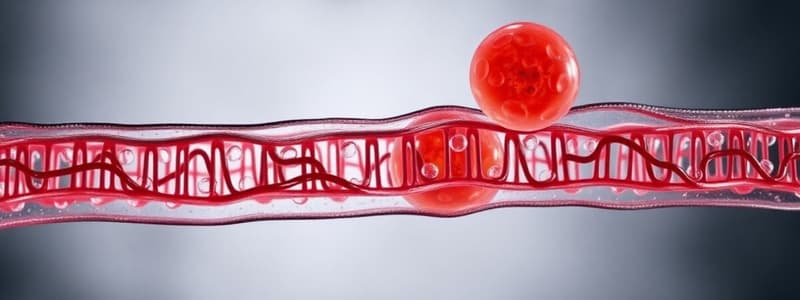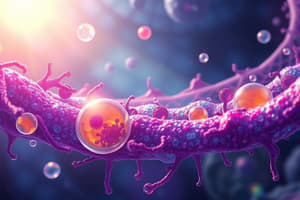Podcast
Questions and Answers
What is the primary function of the cell membrane?
What is the primary function of the cell membrane?
- To produce metabolic wastes
- To provide energy for cellular activities
- To separate extracellular fluid from intracellular fluid (correct)
- To facilitate the reproduction of cells
Which of the following statements about the composition of the cell membrane is correct?
Which of the following statements about the composition of the cell membrane is correct?
- It consists of 55% proteins, 40% lipids, and 5% carbohydrates. (correct)
- It is composed of 55% carbohydrates.
- Proteins make up 40% of the cell membrane.
- Lipids constitute 5% of the cell membrane.
Which part of the cell contains the genetic material?
Which part of the cell contains the genetic material?
- Extracellular fluid
- Cytoplasm
- Cell membrane
- Nucleus (correct)
Which characteristic is NOT true about cells?
Which characteristic is NOT true about cells?
What is the role of cytoplasm in a cell?
What is the role of cytoplasm in a cell?
Which layer of the cell membrane is formed by lipid substances?
Which layer of the cell membrane is formed by lipid substances?
Which system in the human body is responsible for digestion?
Which system in the human body is responsible for digestion?
What is NOT a general characteristic of cells?
What is NOT a general characteristic of cells?
What is the primary function of the glycocalyx in the cell membrane?
What is the primary function of the glycocalyx in the cell membrane?
Which of the following accurately describes the protective function of the cell membrane?
Which of the following accurately describes the protective function of the cell membrane?
What is the key characteristic of rough endoplasmic reticulum (RER)?
What is the key characteristic of rough endoplasmic reticulum (RER)?
How does the cell membrane contribute to maintenance of cell shape?
How does the cell membrane contribute to maintenance of cell shape?
Which of the following substances are NOT expelled through the cell membrane's excretory function?
Which of the following substances are NOT expelled through the cell membrane's excretory function?
What is the primary function of the Rough Endoplasmic Reticulum (RER)?
What is the primary function of the Rough Endoplasmic Reticulum (RER)?
What role does the endoplasmic reticulum play within the cell?
What role does the endoplasmic reticulum play within the cell?
Which of the following substances is primarily synthesized by the Smooth Endoplasmic Reticulum (SER)?
Which of the following substances is primarily synthesized by the Smooth Endoplasmic Reticulum (SER)?
Which type of endoplasmic reticulum is characterized by the presence of ribosomes on its surface?
Which type of endoplasmic reticulum is characterized by the presence of ribosomes on its surface?
What role does the SER play in muscle tissue?
What role does the SER play in muscle tissue?
Which of the following is a function of carbohydrates in the cell membrane?
Which of the following is a function of carbohydrates in the cell membrane?
What is the primary function of the Golgi apparatus?
What is the primary function of the Golgi apparatus?
From which cellular structure are lysosomes formed?
From which cellular structure are lysosomes formed?
Which of the following best describes the structure of a Golgi apparatus?
Which of the following best describes the structure of a Golgi apparatus?
Which face of the Golgi apparatus is associated with receiving vesicles from the endoplasmic reticulum?
Which face of the Golgi apparatus is associated with receiving vesicles from the endoplasmic reticulum?
What type of substances do lysosomes primarily degrade?
What type of substances do lysosomes primarily degrade?
What is the primary characteristic of the lipid bilayer in the cell membrane?
What is the primary characteristic of the lipid bilayer in the cell membrane?
Which part of the phospholipid molecule is hydrophilic?
Which part of the phospholipid molecule is hydrophilic?
What role do channel proteins play in the cell membrane?
What role do channel proteins play in the cell membrane?
What is the function of carrier proteins in the cell membrane?
What is the function of carrier proteins in the cell membrane?
Which substances are able to pass through the lipid layer of the cell membrane?
Which substances are able to pass through the lipid layer of the cell membrane?
What do glycoproteins and glycolipids have in common?
What do glycoproteins and glycolipids have in common?
Which of the following is a function of receptor proteins in the cell membrane?
Which of the following is a function of receptor proteins in the cell membrane?
How do integral proteins contribute to cell adhesion?
How do integral proteins contribute to cell adhesion?
Which type of lysosome is inactive despite containing hydrolytic enzymes?
Which type of lysosome is inactive despite containing hydrolytic enzymes?
What is the primary function of lysosomes in the cell?
What is the primary function of lysosomes in the cell?
How are secondary lysosomes formed?
How are secondary lysosomes formed?
Which enzyme group in lysosomes hydrolyzes nucleic acids?
Which enzyme group in lysosomes hydrolyzes nucleic acids?
What structure within the mitochondrion is responsible for ATP synthesis?
What structure within the mitochondrion is responsible for ATP synthesis?
What is the primary role of mitochondria in cellular functions?
What is the primary role of mitochondria in cellular functions?
What percentage of the total cell volume does the nucleus occupy?
What percentage of the total cell volume does the nucleus occupy?
What is the defining characteristic of eukaryotic cells?
What is the defining characteristic of eukaryotic cells?
What is the primary function of the nucleus in a cell?
What is the primary function of the nucleus in a cell?
What constitutes the major components of the nucleus?
What constitutes the major components of the nucleus?
What is the role of the nucleolus within the nucleus?
What is the role of the nucleolus within the nucleus?
How many pairs of chromosomes are typically found in dividing non-reproductive human cells?
How many pairs of chromosomes are typically found in dividing non-reproductive human cells?
What is chromatin primarily composed of?
What is chromatin primarily composed of?
What structure regulates communication between the nucleoplasm and the cytoplasm?
What structure regulates communication between the nucleoplasm and the cytoplasm?
Which function of the nucleus involves the transmission of genetic information?
Which function of the nucleus involves the transmission of genetic information?
What is the composition of the nucleoplasm?
What is the composition of the nucleoplasm?
Flashcards
Cell
Cell
The basic structural and functional unit of all living organisms. It's the smallest unit that can perform all life processes independently.
Tissue
Tissue
A group of similar cells that work together to perform a specific function. Examples include muscle tissue, nervous tissue, and connective tissue.
Organ
Organ
A structure made up of different tissues that work together to perform a complex function. Examples include the heart, lungs, and stomach.
System
System
Signup and view all the flashcards
Cell Membrane
Cell Membrane
Signup and view all the flashcards
Extracellular Fluid (ECF)
Extracellular Fluid (ECF)
Signup and view all the flashcards
Intracellular Fluid (ICF)
Intracellular Fluid (ICF)
Signup and view all the flashcards
Semipermeable Membrane
Semipermeable Membrane
Signup and view all the flashcards
Lipid Bilayer
Lipid Bilayer
Signup and view all the flashcards
Phospholipid
Phospholipid
Signup and view all the flashcards
Cholesterol
Cholesterol
Signup and view all the flashcards
What does the lipid layer allow to pass through?
What does the lipid layer allow to pass through?
Signup and view all the flashcards
Integral Protein
Integral Protein
Signup and view all the flashcards
Channel Protein
Channel Protein
Signup and view all the flashcards
Carrier Protein
Carrier Protein
Signup and view all the flashcards
Receptor Protein
Receptor Protein
Signup and view all the flashcards
RER's Role in Protein Synthesis
RER's Role in Protein Synthesis
Signup and view all the flashcards
RER's Role in Organelle Degradation
RER's Role in Organelle Degradation
Signup and view all the flashcards
SER's Role in Non-Protein Synthesis
SER's Role in Non-Protein Synthesis
Signup and view all the flashcards
SER's Role in Metabolism
SER's Role in Metabolism
Signup and view all the flashcards
SER's Role in Calcium Storage
SER's Role in Calcium Storage
Signup and view all the flashcards
SER's Role in Detoxification
SER's Role in Detoxification
Signup and view all the flashcards
Golgi Apparatus: What it is
Golgi Apparatus: What it is
Signup and view all the flashcards
What does the Golgi Apparatus do?
What does the Golgi Apparatus do?
Signup and view all the flashcards
Lysosomes
Lysosomes
Signup and view all the flashcards
Primary lysosome
Primary lysosome
Signup and view all the flashcards
Secondary lysosome
Secondary lysosome
Signup and view all the flashcards
Mitochondria
Mitochondria
Signup and view all the flashcards
Cristae
Cristae
Signup and view all the flashcards
Nucleus
Nucleus
Signup and view all the flashcards
Eukaryotes
Eukaryotes
Signup and view all the flashcards
Prokaryotes
Prokaryotes
Signup and view all the flashcards
Glycocalyx
Glycocalyx
Signup and view all the flashcards
Glycocalyx Function: Barrier
Glycocalyx Function: Barrier
Signup and view all the flashcards
Glycocalyx Function: Cell Adhesion
Glycocalyx Function: Cell Adhesion
Signup and view all the flashcards
Cell Membrane Function: Protection
Cell Membrane Function: Protection
Signup and view all the flashcards
Cell Membrane Function: Selectivity
Cell Membrane Function: Selectivity
Signup and view all the flashcards
Cytoplasm
Cytoplasm
Signup and view all the flashcards
Endoplasmic Reticulum (ER)
Endoplasmic Reticulum (ER)
Signup and view all the flashcards
Rough ER (RER)
Rough ER (RER)
Signup and view all the flashcards
What does the nucleus control?
What does the nucleus control?
Signup and view all the flashcards
What is the nuclear membrane?
What is the nuclear membrane?
Signup and view all the flashcards
What is nucleoplasm?
What is nucleoplasm?
Signup and view all the flashcards
What is chromatin?
What is chromatin?
Signup and view all the flashcards
What is a chromosome?
What is a chromosome?
Signup and view all the flashcards
What is the nucleolus?
What is the nucleolus?
Signup and view all the flashcards
How do ribosome subunits form?
How do ribosome subunits form?
Signup and view all the flashcards
What is the role of mRNA?
What is the role of mRNA?
Signup and view all the flashcards
Study Notes
Introduction
- Cells are the fundamental structural and functional units of living organisms.
- Cells group together to form tissues, which then combine to form organs and systems.
- The body's systems work together to maintain homeostasis and overall health.
- Cells need nutrients, oxygen, and energy for survival and growth.
- Cells produce energy, eliminate waste products, and respond to internal and external stimuli.
- Reproduction, through cell division, ensures continuation of life.
General Cell Characteristics
- All cells require nutrients and oxygen.
- Each cell produces energy for its functions.
- Cells eliminate metabolic waste products.
- Cells maintain a stable internal environment to support processes.
- Cells respond to invaders.
- Cells multiply through division (except some like neurons).
Cell Structure
- A cell comprises a cell body and a surrounding cell membrane.
- The cell body contains a nucleus and cytoplasm.
- Three main components are studied: cell membrane, cytoplasm, and nucleus.
Cell Membrane
- A protective layer, also known as the plasma or plasmalemma.
- Separates intracellular fluid (inside the cell) from extracellular fluid (outside the cell).
- A semipermeable membrane.
- Consists of lipids (phospholipids and cholesterol) and proteins.
Cytoplasm
- Gel-like material filling the cell body.
- Contains various organelles with specific functions.
- Cytoplasm includes cytosol, organelles, and various other particles.
Nucleus
- The control center of the cell.
- Contains the cell's genetic material (DNA).
- A membrane-bound organelle.
- Contains nucleoplasm and nucleoli.
- Important for cell division and protein synthesis.
Other Organelles (Page 4-5)
- Endoplasmic Reticulum (ER): A network of tubules; rough ER is studded with ribosomes (involved in protein synthesis), while smooth ER lacks ribosomes (involved in lipid synthesis and detoxification).
- Golgi Apparatus: Processes and packages proteins and other molecules.
- Lysosomes: Contain enzymes for breaking down cellular waste and debris.
- Mitochondria: "Powerhouses" where energy is produced (ATP).
- Ribosomes: Involved in protein synthesis.
- Vacuoles/Vesicles: Membrane-bound sacs for storage and transport.
Membrane Carbohydrates
- Some membrane carbohydrates are attached to proteins (glycoproteins) or lipids (glycolipids).
- Carbohydrate molecules form a layer called glycocalyx.
Functions of Cell Membrane
- Protective barrier
- Selective permeability (controlling what enters and exits)
- Absorption and excretion
- Gas exchange
- Maintaining cell shape and size
Functions of Nucleus
- Controlling all cell activities.
- Synthesizing RNA.
- Forming ribosome subunits.
- Directing protein synthesis.
- Controlling cell division.
- Storing genetic information.
Studying That Suits You
Use AI to generate personalized quizzes and flashcards to suit your learning preferences.
Related Documents
Description
Test your knowledge on cell membranes, organelles, and their functions with this comprehensive quiz. From the role of the cell membrane to the importance of the rough endoplasmic reticulum, each question delves into the essential characteristics of cells and their components. Challenge yourself and enhance your understanding of cellular biology!




